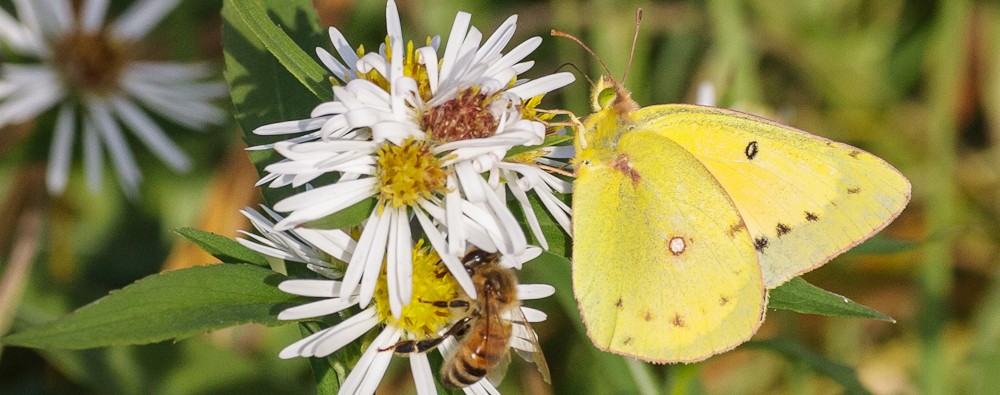Cranberries, especially in the form of relishes and baked goods, are a Thanksgiving tradition made possible by Cranberry (Vaccinium macrocarpon), a low-growing, creeping, evergreen shrub native to North American bogs and fens. Cranberry lends itself well to cultivation for commercial use, making cranberry based dishes possible throughout the year.
The flowers of this native shrub bloom in early to mid-summer, a prerequisite for the fruit that will come later in the season.
In order to produce the tart but luscious and festive fall fruit, Cranberry’s flowers must be pollinated with assistance from insects, primarily bees.
The flowers are most efficiently pollinated by bees who are capable of sonication, or buzz pollination. In the case of Cranberries, this process is performed by bees that are able to hang upside down from the bottom edge of the flower’s corolla (collection of petals) and vibrate their wing muscles without moving their wings. This sets up just the right motion to release pollen from the flower like salt from a shaker dusting the bee’s underside. When the bee moves on to the next flower, its pollen-dusted abdomen brushes the flower’s stigma (female reproductive part), depositing pollen from the previous flower.
It’s not every bee that has this special talent. Honey Bees don’t have the skills necessary to buzz pollinate. The best Cranberry pollinators are the native bees with which it has evolved, and who can sonicate (buzz pollinate), including several species of Bumble Bees, Sweat Bees (Halictidae) and Mining Bees (Andrenidae). The presence of these native bees significantly increases the yield of commercial cranberry operations.

Bumble Bee getting in position to buzz pollinate a Shooting Star (Dodecatheon Meadia) flower. The structure of this flower is very similar to those of Cranberry (Vaccinium macrocarpon).
Other food we eat, including blueberries, tomatoes, eggplant, and peppers are produced by plants whose flowers are also most effectively pollinated through buzz pollination.
With the help of the bees, this tough little shrub produces abundant fruit that ripens in the fall and resists spoiling, perfect timing for inclusion in a late fall or winter feast.
In addition to being tasty and nutritious, Cranberry has medicinal value. Consumption of cranberries or unsweetened cranberry juice can help prevent urinary tract infections.
Humans are not the only consumers of cranberries. Birds including Sharp-tailed and Ruffed Grouse, Bobwhites, Mourning Doves and American Tree Sparrows are known to eat cranberries,
as are Chipmunks.
Cranberry hosts the caterpillars of several moths who can only eat the leaves of this and a few related species. The Bog Copper butterfly is also a specialist on Cranberry and the closely related Small Cranberry (Vaccinium oxycoccus).
Cranberry is indigenous in the United States from Maine to Minnesota, south from northeastern Illinois to Delaware, and from there reaching as far south as Tennessee and North Carolina primarily through the Appalachians; it can also be found in coastal Washington state and Oregon, and Nevada county in California. In Canada it is native from Newfoundland to Ontario, in British Columbia and the Northwest Territories. The top five states in commercial cranberry production are Wisconsin, Massachusetts, New Jersey, Oregon and Washington. British Columbia and Quebec are the top cranberry producing provinces in Canada.
Why is the range of this plant primarily in northern latitudes and higher elevations? The answer lies in the fact that Cranberry is much less successful in producing flowers and fruit unless it goes through a sufficient period of dormancy induced by day length change and cold temperatures. To successfully break dormancy, the plants must experience a cumulative number of ‘chill hours’, usually defined as temperatures between 32 and 45 °F (0 – 7.2 °C), during the winter months. A study done by University of Wisconsin researchers found that 1500 chill hours seemed to be in the optimal range for successful bloom of cranberry flowers. As the climate changes and night time temperatures warm, the geographic range where these optimal conditions can be met may shrink.
Enjoy those cranberry dishes while you can!
Related Posts
Love Blueberries? Thank a Native bee
Resources
Cech, Rick; Tudor, Guy. Butterflies of the East Coast. 2005.
Eastman, John. The Book of Swamp and Bog. 1995.
Eaton, Eric R.; Kauffman, Ken. Kaufman Field Guide to Insects of North America. 2007.
Foster, Steven; Duke, James A. A Field Guide to Medicinal Plants and Herbs of Eastern and Central North America. 2000.
Hoffmann, David. Medical Herbalism. 2003.
Rhoads, Ann Fowler; Block, Timothy A. The Plants of Pennsylvania. 2007
Biobest Sustainable crop Management
Illinois Wildflowers
https://illinoiswildflowers.info/plant_insects/plants/vaccinium_macrocarpum.html
http://www.illinoiswildflowers.info/flower_insects/plants/lg_cranberry.htm
Lady Bird Johnson Wildflower Center Plant Database
University of Wisconsin Extension; Cranberry Crop Management Journal
University of Massachusetts, Natural History of the American Cranberry (Vaccinium macrocarpon)
US Forest Service – What is a Fen?
WisCONTEXT: Pollinators Provide Extra Buzz To Wisconsin’s Cranberry Crop
https://www.wiscontext.org/pollinators-provide-extra-buzz-wisconsins-cranberry-crop




















































